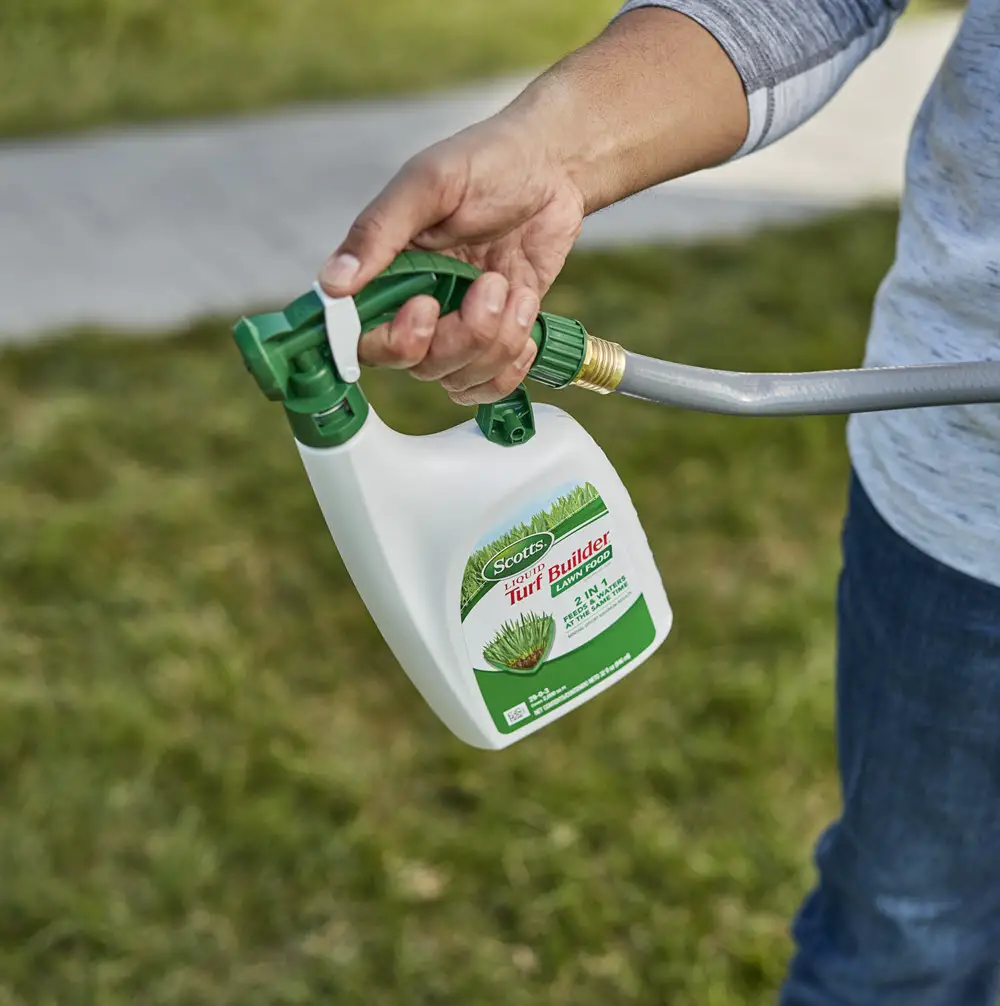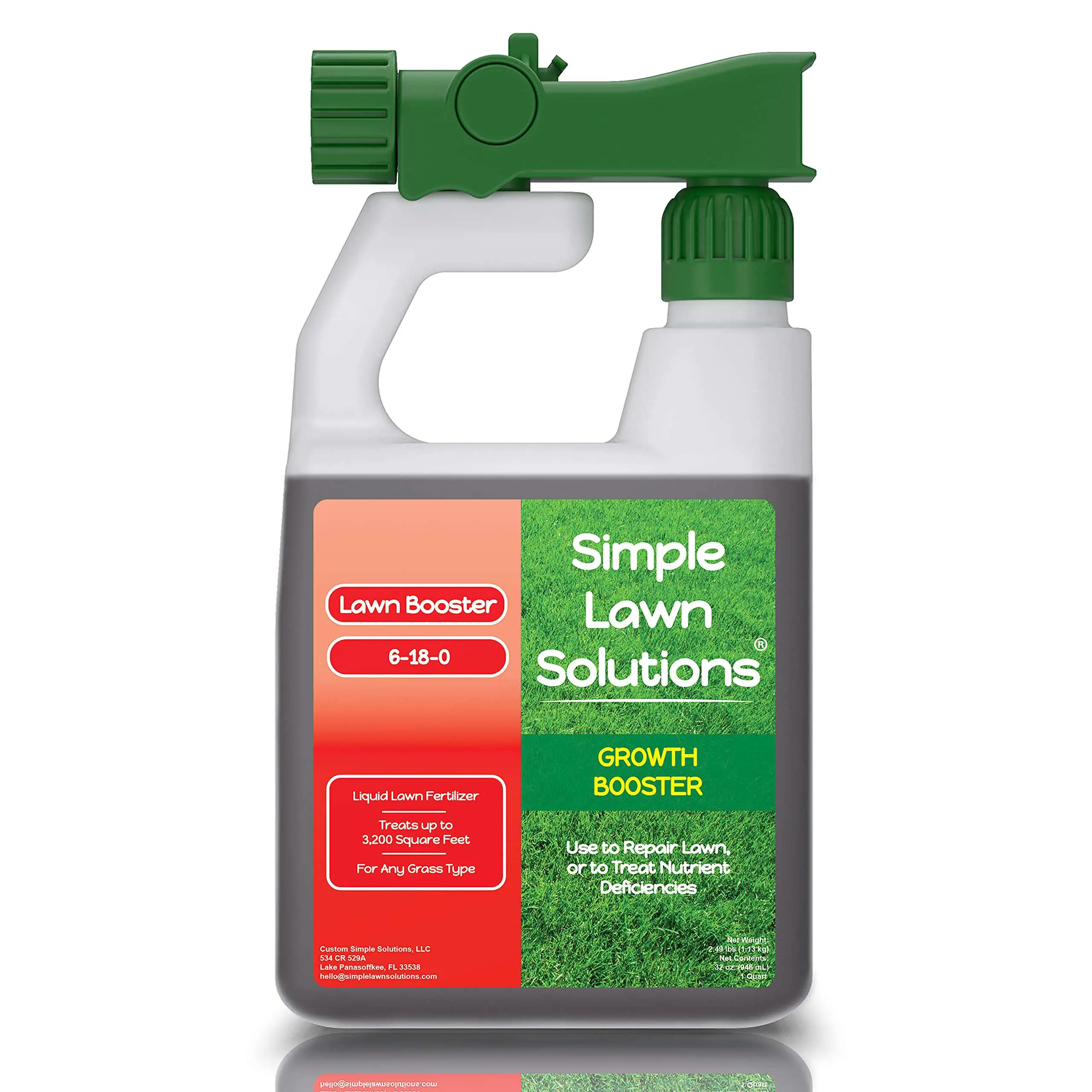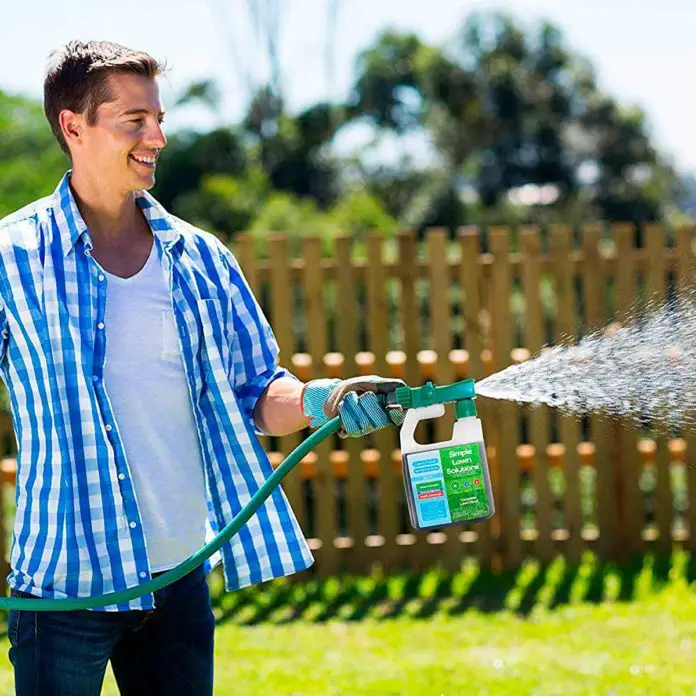How Much Liquid Lawn Fertilizer Should You Apply
There are plenty of fertilisation tools to help ensure your lawn gets an even coverage
Using a spray bottle for liquid fertiliser means no section gets more fertilised than another.
A uniformly fertilised lawn benefits the grass.
Applying too much fertiliser and too little fertilizer in one section will lead to a patchy lawn.
Instead of a luscious green lawn, you will have brown patches from over fertilisation, these patches will be contrasted by emerald green patches where the grass has been treated properly.
How much fertiliser to put in the spray bottle is another question and depends on a number of things.
The condition of the lawn, the type of grass laid, and the manufacturers instructions.
Before either application, in spring or fall, you have to measure the fertiliser concentration precisely.
You May Like: Depression In Yard
Disadvantages Of Liquid Lawn Fertilizer
The main disadvantage of liquid lawn fertilizers is that they need to be applied frequently. They are fast-release fertilizers that provide instant result but it is short-lived. Another disadvantage is that applying too much liquid fertilizer can burn your lawn and damage your plants.
Another disadvantage of liquid lawn fertilizers is their higher total cost. Because they need to be applied more frequently than granular lawn fertilizers, their total cost is higher. However, the cost of quality liquid grass feed is offset by its ease of use. If you decide to go for organic liquid lawn fertilizers, the price can be even higher.
How Does Liquid Fertilizer Work
Weve already established that fertilizer is food for plants, but how does that food get from the fertilizer to the plant? There are a couple of ways.
With a granular fertilizer, over time the granules begin to break down and the soil slowly absorbs the nutrients. Your grass then pulls these nutrients through the soil into its root system.
On the other hand, liquid fertilizer feeds grass in two ways: through the soil into the roots and directly through the grass blades.
Like a granular fertilizer, any liquid fertilizer that makes it to the ground will then seep into the soil where the grass roots can absorb the nutrients. However, when using liquids, the grass is primarily absorbing the fertilizer through its blades.
This is known as foliar absorption.
The absorption through the foliage happens much quicker than through the roots which is why you can almost see an immediate response when applying liquid fertilizers!
However, there is a trade-off.
Liquid fertilizer will not have the same slow-release abilities as granular fertilizer. This means liquids are best suited for light, frequent feedings, or as a supplement to granular fertilizer during the growing season.
Read Also: Bayer Bioadvanced Fungus Control
Also Check: How To Get Rid Of Crabgrass In Zoysia Lawns
Youve Watered After Fertilizing Now What
After this initial watering, avoid watering your lawn for a couple days so the nutrients can settle in. Then, return to your regular lawn-watering schedule, and remember these tips:
- Dont water every day. Water deeply and infrequently. Water too often, and it encourages shallow, needy roots. Water less often but deeply, and roots will grow deeper and healthier and be happy with less water. Grass needs about an inch of water each week.
- Early morning is the best time to water. Its still cool, so all that valuable water wont evaporate in the hot sun. Wrap up your watering as close to sunrise as possible. If sunrise is at 6 a.m., you should be done watering at 6.
After Fertilizing Your Lawn When Is It Safe To Let Your Pets On The

After Fertilizing Your Lawn, When Is it Safe to Let Your Pets on the
Using liquid fertilizer on a lawn has the benefit of allowing the soil to absorb the nutrients faster than a granular type of fertilizer, but determining grass safety after application is tricky.Most liquid fertilizer manufacturers suggest using water along with the fertilizer for soil solubility.The grass blades should not have any residual fertilizer if it was applied according to the manufacturer’s instructions.Allow pets back onto the lawn after 24 hours have elapsed from the last time you saw granules on the grass blades.A full day allows the fertilizer to soak deep into the soil and provides evaporation time for the water. .
You May Like: When To Dethatch Lawn In Virginia
Section 6 Of : Should You Water After Applying Liquid Fertilizer
The Disadvantages Of Liquid Fertilizer
The liquid nutrients soak into your lawn fast, but that also means they dont last as long. Those quick results you see will soon fade.
Thats why youll notice that lawn care companies who use liquid fertilizer will recommend more frequent applications to keep those green results going.
Pesticides may be mixed in with your liquid fertilizer for one-stop ease of application. That means theyll be applied over your entire lawn, even on areas that may not need it.
Some of the fertilizer may run off and not make it into your soil.
Liquid lawn fertilizer is usually applied with a long spray hose. If its windy, the liquid can spray off, missing your lawn.
Donât Miss: How To Kill Clovers Without Killing Grass
Recommended Reading: Where To Dump Old Lawn Mower
Which Is Better As A Starter Fertilizer
As we mentioned earlier when discussing the high salt content of granular fertilizer, some major factors need to be considered when choosing a starter fertilizer. By starter fertilizer, we mean a fertilizer that is applied for new grass or plants. That could mean anything from fertilizing grass seeds and plant seeds to fertilizing new sod. Liquid fertilizer is the preferred method for starter fertilizer, because your new roots wont strategically avoid the fertilizer and nutrients. Liquid fertilizer is the best way to stimulate your new roots to flourish on your lawn.
Read Also: How To Kill Wild Violet Weeds In Lawn
Liquid Lawn Fertilizer Application
Liquid lawn application is as simple as watering your lawn. With hose in hand, you just spray evenly to apply the fertilizer to your lawn. If you know how to water a lawn without creating puddles, then you can apply liquid lawn fertilizer evenly. An even application of fertilizer will create that even, green, lush lawn youve been working towards without the risk of overgrown or undergrown patches. Having a lawn that grows evenly means the rest of your lawn care regimen stays intact, such as mowing and watering. Having an even lawn without any weak patches can also protect your lawn from unwanted guests, like invasive weeds.
Don’t Miss: Who Makes The Best Lawn Mower Blades
Easy To Apply Nutrients
Most liquid nitrogen fertilizers can simply be attached to a garden hose for easy and convenient application. These products provide a consistent nutrient application in an even manner as the components are sprayed within the viscous form. This means, your entire lawn will receive the same amount of fertilizer throughout.
Fertilizer : The Why What How And When To Fertilize Your Lawn
Fertilizer 101: The Why, What, How, and When to Fertilize Your Lawn
Why should I fertilize my lawn?Over time, many lawns will leech nutrients out of their soil.Most nutrients for your lawn are water-soluble.They go to the store and see countless bags of fertilizer, all containing complex words and number ratios.Although it might look intimidating, most fertilizers are made up of three different nutrients: Nitrogen, Phosphorus, and Potassium. Phosphorus helps your lawn develop healthy roots and stems.These numbers are the percentages of nitrogen , phosphorus , and potassium , or N-P-K ratio, of the fertilizer.Although they work very well, these types of fertilizers also have a few drawbacks.These types of fertilizers have a higher chance of leaching when applied in high doses.When should I fertilize my lawn? .
You May Like: What Oil For Lawn Mower
Why Use Chelated Iron
Iron is an essential part of getting a truly green lawn and is fundamental in the plants process of photosynthesis.
Its not just for lawns it will help just about any other plant you have in your garden, including flowers and vegetables.
How often you need to add chelated iron to your turf depends on the current condition of the grass.
If the lawn is already losing color and your grass is more yellow than green, you may need to distribute chelated iron up to 10 times each year. If your grass is mostly healthy by needs a boost, 3-4 applications each year should be plenty.
Always evenly spread the product on your lawn to achieve a uniform look. And make sure to follow the manufacturers directions about how much product to use. These free online lawn square footage calculators can help you get a really accurate application .
Some chelated iron products have formulas that are also rich in other macro-nutrients that are essential for healthy plant life. Others may only provide an iron supplement. Which type of iron product is best for your lawn will depend upon the rest of your lawn care and fertilizer plan.
When And How Often Should You Apply Plant Fertilizer: Tips Timing

When and how often should you apply plant fertilizer: Tips, timing
The worst time to fertilize plants is at the end of their growing season.Trees, for example, begin to wake up and grow in early spring, and typically are fertilized once in February or March.Most shrubs make active growth in the spring and early summer, so we tend to fertilize them once around March or April.Louisiana irises, for instance, are at the end of their growing season in spring, and are dormant over the summer.Soluble fertilizers, for instance, are applied every two weeks during the growing season.Slow-release fertilizers work for months, so one application is generally all that is needed for a growing season. .
Don’t Miss: How To Restore Grass Lawn
Foliar Feeding Plants And Gardens With Bio
16-4-8 is considered a high nitrogen fertilizer which means it works well for most non-blooming green or leafy plants including vegetables, house plants, shrubs and even trees. It promotes green growth, as opposed to promoting flowers or fruits. We recommend 16-4-8 be used foliarly or through drip irrigation during the Growth Stage of your plants, up to the time they begin blossoming. For trees, use during the initial growth flush stage.
What Does Iron Do For Lawns
Greener lawns have a healthier look. Thats not just visual confusion, either. If your turf is discolored, then that suggests the grass is fundamentally unhealthy.
Sure, sunlight and water can do a lot for your lawn. But sometimes you just need to give Mother Nature a helping hand by boosting the nutrients in your soil.
Iron, and especially chelated iron, are hardly new for managing lawns. In fact, some popular fertilizers already have iron in them and listed on their packages.
Of course, its no secret that plants need some basic nutrients and chemicals to survive. Thats why every bag of fertilizer has the big three nutrients listed front and center.
But plants also need iron to reach their full potential. Especially for a fully grown and healthy lawn, iron is a fundamental part of the puzzle.
Read Also: What Kills Creeping Charlie Weeds
Read Also: How To Get Rid Of Weeds In Lawn Pet Friendly
How Much Fertilizer To Apply
For most people, dry, granular lawn fertilizers are the easiest to use evenly. Liquid or water-soluble fertilizers could also be useful for little lawns, but theyre harder to use evenly and should need frequent refilling.
For dry fertilizers, the rates are based on pounds to use per 1000 square feet. So, before you purchase, calculate the square feet area of your lawn.
The front of the fertilizer package will call out amounts like 7,000 or 10,000 square feet. Decide whats best for your lawn size. Remember, extra fertilizer can be packed back in the bag and saved for future application.
Theres an adequate time for the application of the lawn fertilizer too. Read everything about the right time to apply lawn fertilizer.
Nutritional Needs For Lawns
Nitrogen is the most important nutrient for your lawn, followed by phosphorus and potassium. Different types of lawns require different percentages of these three main nutrients, and the time of year also impacts what type of fertilizer your lawn needs. Knowing what type of grass seed your lawn is made up of can help you determine your fertilizer needs. For example, high maintenance lawns made of grass like improved Kentucky bluegrass requires more fertilizer in a year than a low maintenance grass like common Kentucky bluegrass or hard fescue. Most of the time, you will find lawn fertilizers with certain percentages of nitrogen, phosphorus, and potassium, although there are many variations.
Recommended Reading: What Is The Best Insect Control For Lawns
Liquid Vs Granular Fertilizer
Knowing what fertilizer to use depends on several factors. See the pros and cons of the two main types of fertilizer below:
Liquid o Pros works quickly, actual chemicals cost lesso Cons cost of sprayers, doesnt last as long Granularo Pros lasts longer, lower equipment cost, easy to applyo Cons more lawn prep required , cleanup from overspill
How Much Liquid Nitrogen Fertilizer To Apply
How much liquid nitrogen fertilizer you should apply depends on your lawns size and how much nutrient it needs throughout the year. If you apply too little, you wont get the desired results apply too much and you may damage your grass, so it pays to know the right amount of fertilizer to apply.
Soil Testing
The best way to determine how much liquid fertilizer you need to apply is to test your soil. By using a soil test kit, you will know how much nitrogen, phosphorus, and potassium your lawn needs. There are many simple to use home test kits that measure all three of the main nutrients in your soil. The ones we like are in the form of capsules from Luster Leaf.
Once you find out your soils deficiencies, you can then choose the right fertilizer. Check the products NPK ratio and be sure to follow the instructions.
Don’t Miss: How To Apply Fungus Control For Lawns
How Long Will Liquid Fertiliser Last
For most lawns, an application twice a year is all that is needed. An application in Spring will last then until Fall.
The Spring application encourages strong growth for the Summer, then the Fall application boosts the nutrients of the soil to help the lawn survive the winter.
In storage, fertiliser can last for years up to 10 years however, proper storage is key to ensure this longevity.
Without proper storage, fertiliser can begin caking, leaking and in some instances can become hazardous.
When Should I Fertilize My Lawn Using Liquid Compost

Once the grass starts to green up in early spring, all lawns require fertilizer. The type of grass, nutritional compost, and climate influence your fertilization plan throughout the season.
Most lawn seed is a blend of many distinct species of grasses, and fertilizing from the spring to fall is ideal. The label on the product is your most excellent guide regarding how often and how much to apply it.
Your grass will grow as long as you do not overdo it and minimize the amount of organic fertilizer during the warmest portion of the summer .
So, the ideal lawn fertilizer schedule is after cutting the initial flush of grass from the soil. Besides, grass will grow strong to endure the winter if you feed them between September 1 and October 1.
Read Also: How To Kill Creeping Charlie In Lawn
How To Fertilize Your Lawn In The Fall
Approach your fall fertilizer application just as you would any other. Follow the coverage recommendation for the chosen product. Its always a good idea to split the application in half and then make two passes in different directions. For example: if your fall fertilizer bag says it will cover 5,000 square feet, find the setting on your spreader for 10,000 square feet . This will close the spreader gate allowing only one-half the recommended rate to flow through. Then make two consecutive passes at this spreader setting. This will apply the total recommended amount using two passes instead of one. This ensures even, uniform coverage, reducing the risk of missing parts of your lawn.
After youve finished your fall fertilizer application, make sure you thoroughly wash your spreader. This removes any remaining fertilizer residue that can corrode spreader components over the winter. Refer to your owners manual for additional recommended maintenance before winter storage.
How Long Should You Water Your Lawn After Fertilizing
You should moisten the soil and fertilizer thoroughly, but not to the point where puddles develop. It should just take about twenty minutes.
You do not want to flush away all those beneficial nutrients or let the fertilizer wash away with the water, contaminating groundwater and neighboring streams, rivers, and ponds.
If you are watering your garden after fertilization with sprinklers and hoses rather than irrigation facilities, ensure you move this equipment around to provide a beautiful, level coverage over regions of your grass.
Read Also: How To Rid Lawn Of White Clover
Start With A Soil Test
Begin with a soil test. Feeding your lawn nutrients it doesnt need is wasteful. A soil test analyzes the pH of your soil as well as key nutrients. You can take a soil sample to your local extension office for analysis or you can purchase a DIY soil test kit. Once you have the results of the test, you will know which nutrients you need to apply and you can research the best way to apply them.